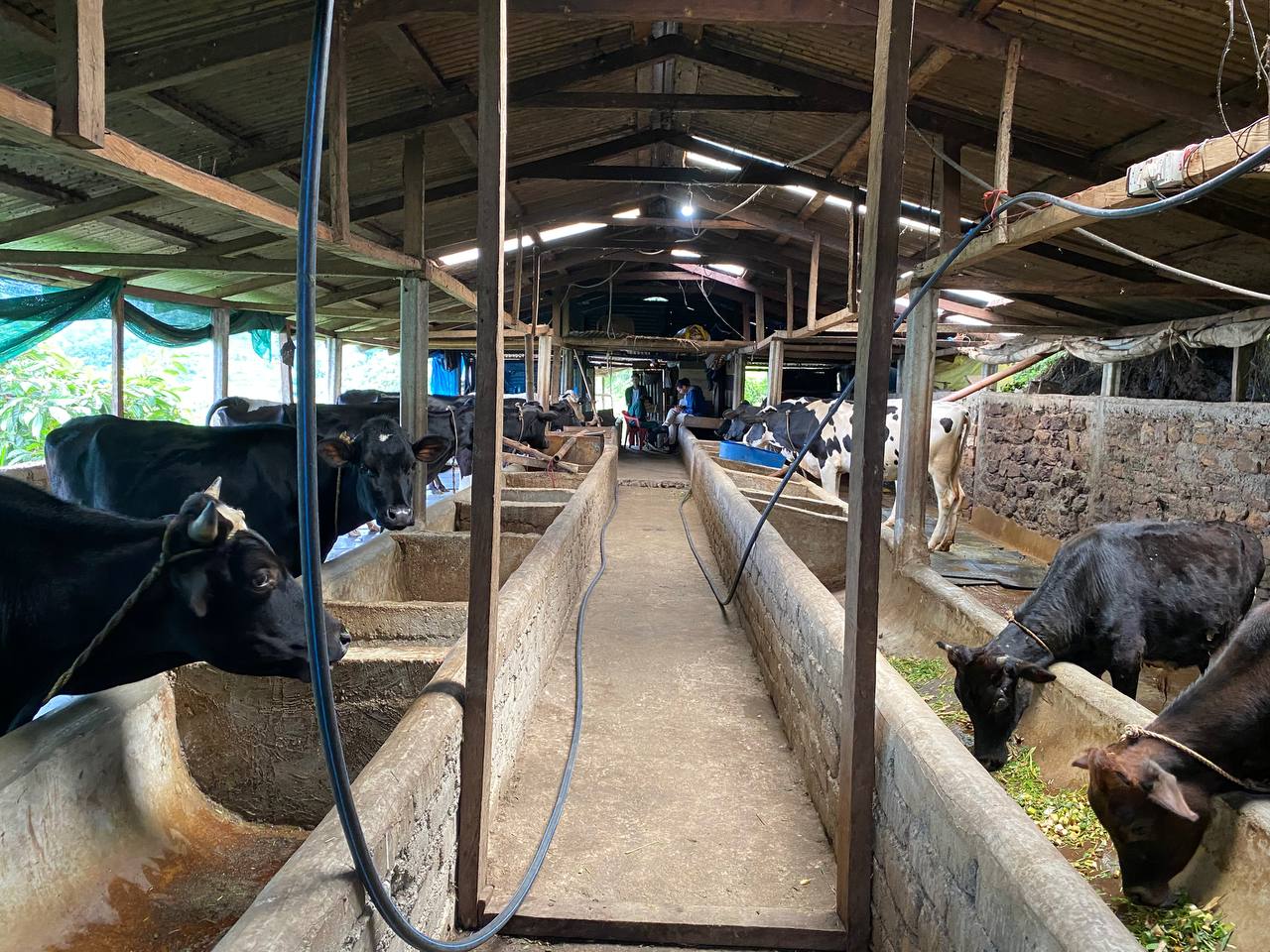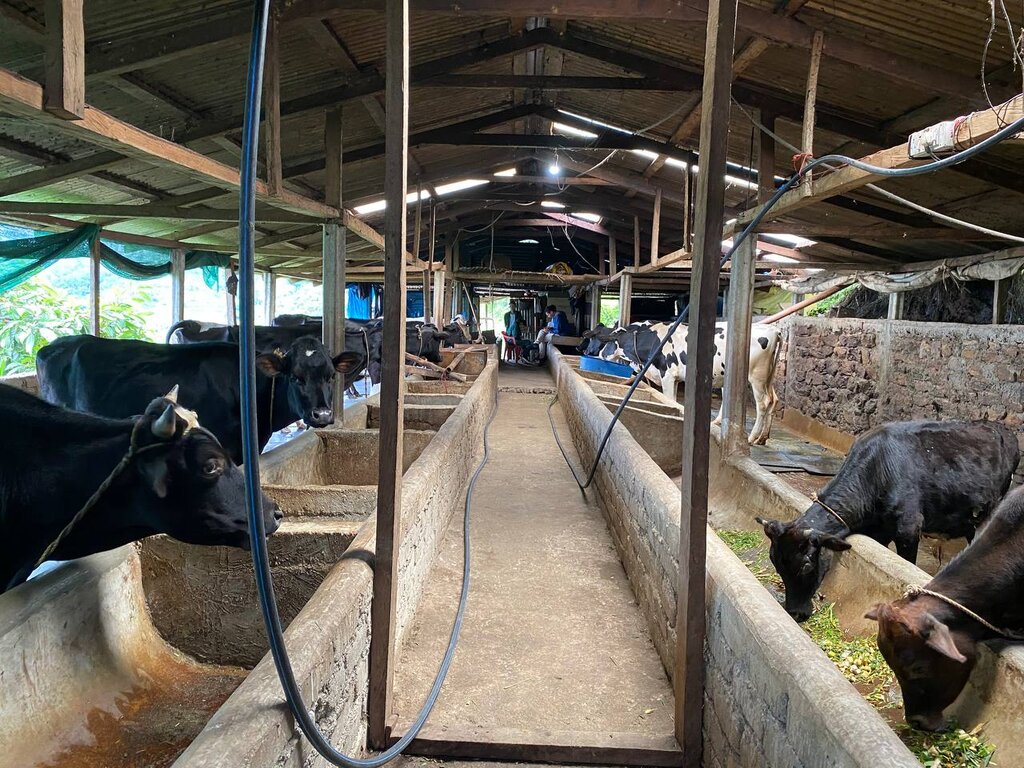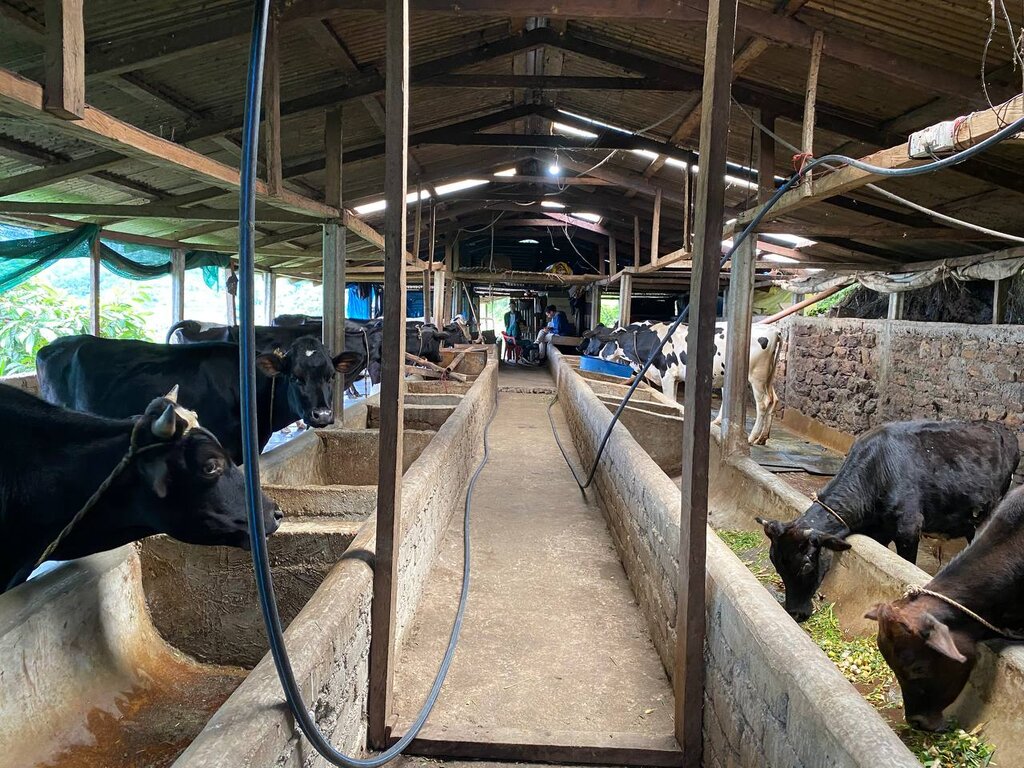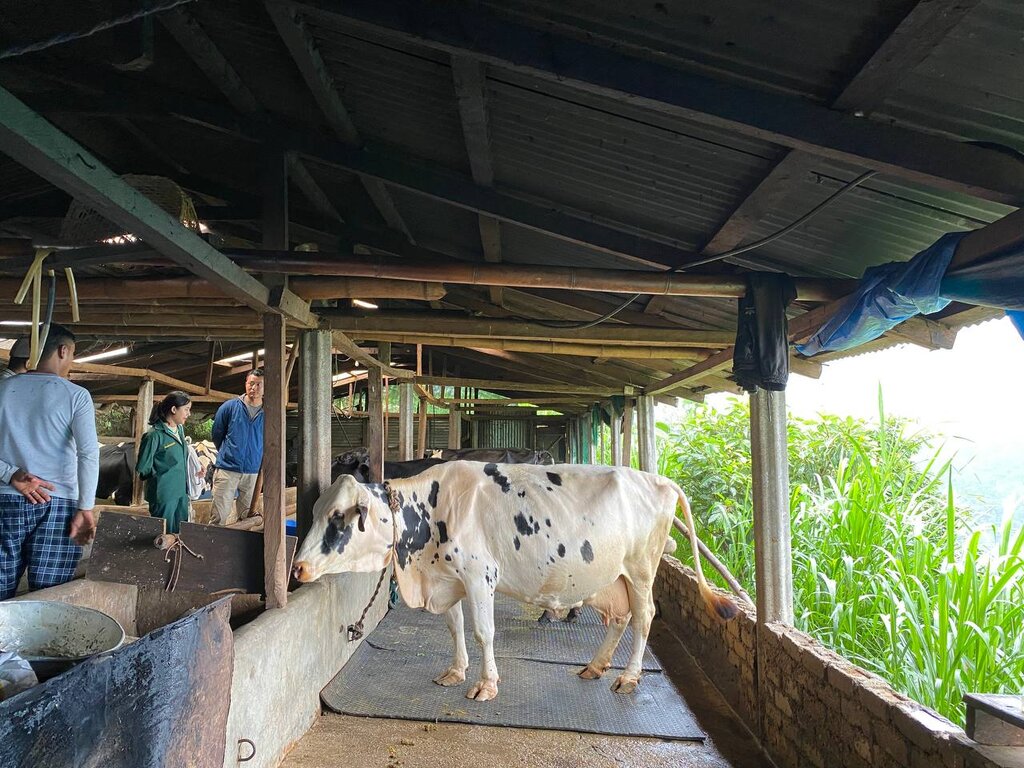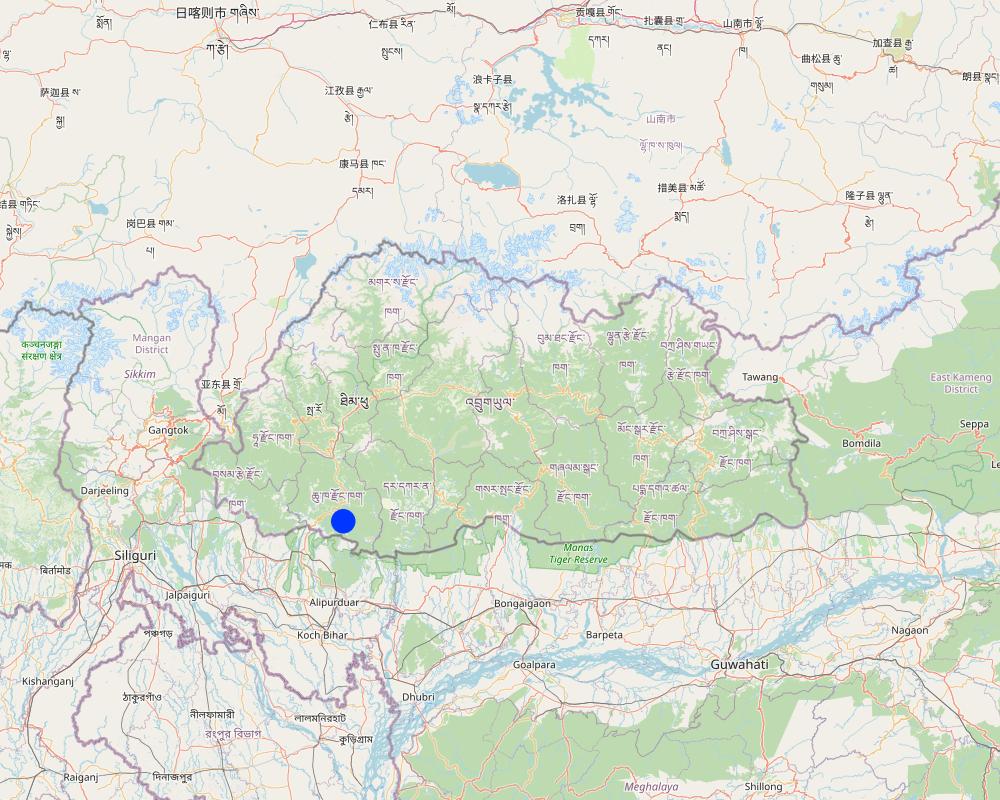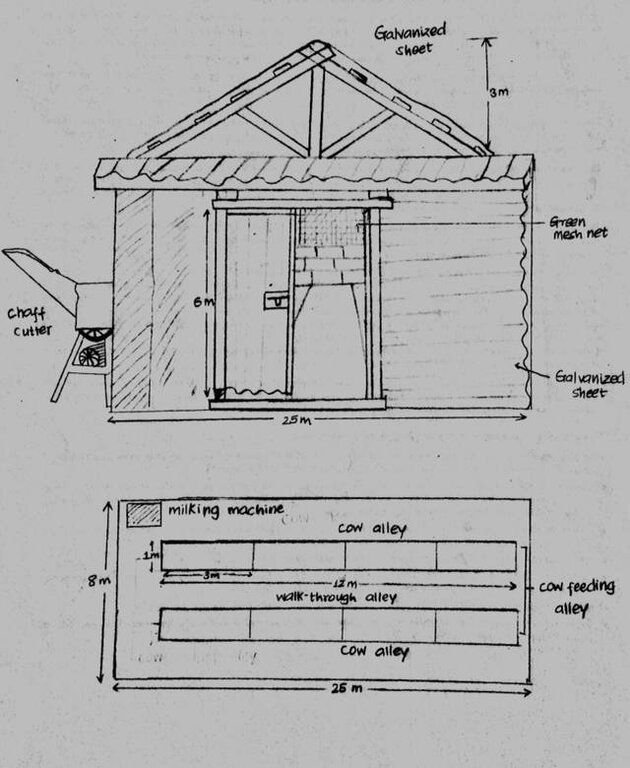Stall-Feeding of Dairy Cows [ภูฏาน]
- ผู้สร้างสรรค์:
- การอัพเดท:
- ผู้รวบรวม: Karma Wangdi
- ผู้เรียบเรียง: Tashi Wangdi
- ผู้ตรวจสอบ: William Critchley, Rima Mekdaschi Studer
Tsachhag Jintey Nor Sochong Baeni (ཙྭ་ཆག་བྱིན་ཏེ་ནོར་གསོ་སྐྱོང་འབད་ནི།)
technologies_6869 - ภูฏาน
ดูส่วนย่อย
ขยายทั้งหมด ย่อทั้งหมด1. ข้อมูลทั่วไป
1.2 รายละเอียดที่ติดต่อได้ของผู้รวบรวมและองค์กรที่เกี่ยวข้องในการประเมินและการจัดเตรียมทำเอกสารของเทคโนโลยี
วิทยากรหลัก
ผู้ใช้ที่ดิน:
Chettri Hemlal
Arekha, Darla Gewog (Block), Chhukha Dzongkag (District)
ภูฏาน
ชื่อของโครงการซึ่งอำนวยความสะดวกในการทำเอกสารหรือการประเมินเทคโนโลยี (ถ้าเกี่ยวข้อง)
Strengthening national-level institutional and professional capacities of country Parties towards enhanced UNCCD monitoring and reporting – GEF 7 EA Umbrella II (GEF 7 UNCCD Enabling Activities_Umbrella II)1.3 เงื่อนไขการใช้ข้อมูลที่ได้บันทึกผ่านทาง WOCAT
ผู้รวบรวมและวิทยากรหลักยอมรับเงื่อนไขเกี่ยวกับการใช้ข้อมูลที่ถูกบันทึกผ่านทาง WOCAT:
ใช่
1.4 การเปิดเผยเรื่องความยั่งยืนของเทคโนโลยีที่ได้อธิบายไว้
เทคโนโลยีที่ได้อธิบายไว้นี้เป็นปัญหาของความเสื่อมโทรมโทรมของที่ดินหรือไม่ จึงไม่ได้รับการยอมรับว่าเป็นเทคโนโลยีเพื่อการจัดการที่ดินอย่างยั่งยืน:
ไม่ใช่
แสดงความคิดเห็น:
This technology does not have any problem with regard to land degradation
2. การอธิบายลักษณะของเทคโนโลยี SLM
2.1 การอธิบายแบบสั้น ๆ ของเทคโนโลยี
คำจำกัดความของเทคโนโลยี:
Stall-feeding is an improved cattle production system, which is increasingly being adopted with a growing population of high yielding exotic dairy breeds. Thus, most improved dairy cattle in Nepal are being reared under confinement with limited access to grazing, as it allows for easy and optimal supplementation of fodder.
2.2 การอธิบายแบบละเอียดของเทคโนโลยี
คำอธิบาย:
Stall-feeding, or “zero-grazing”, is a livestock management approach that confines animals within stalls or pens for feeding. It offers various advantages, such as improved waste management, precise nutrition control, and reduced risk of overgrazing. It allows farmers to carefully regulate their animals' diets to ensure they receive the necessary nutrition for optimal growth and productivity (Hadush, 2002). To effectively implement stall-feeding, several key components are required. Firstly, animals must be housed in separate stalls of appropriate size to facilitate cleaning and waste collection. Secondly, a well-planned feeding system is essential, which may involve the use of automatic feeding equipment, or alternatively manual distribution of hay, grains, and supplements tailored to each breed’s unique nutritional needs. Thirdly, a comprehensive waste management system is crucial to handle the manure produced by confined animals, which involves thorough stall cleaning and composting, transforming waste into organic fertilizer. Proper water supply and ventilation are also imperative for the animals' health and well-being. Adhering to these technical requirements (Garber, 2010) ensures optimal productivity and animal welfare in the stall-feeding system.
Stall-feeding is employed in various agricultural contexts worldwide, particularly where traditional open grazing is impractical or unsustainable. It is applied in areas with limited grazing land and high population density, such as urban and peri-urban settings. Moreover, it may be used in arid or semi-arid regions with scarce natural pastures, as well as during dry seasons when grazing resources are scarce. Smallholder farms and intensive livestock production systems aim to maximize output while optimizing resource usage, making stall feeding a prevalent practice. Dairy farming employs stall-feeding to boost milk production and enhance the quality of dairy products (Oosting et al., 2021).
According to Sahoo et al. (2015), the primary objective of stall-feeding is to provide controlled and ideal conditions for managing and feeding cattle. This approach ensures that animals are housed indoors according to their age, sex, breed, and weight, preventing them from grazing outdoors. To establish a well-functioning system, several crucial steps must be taken. First and foremost is the construction of individual stalls or pens, with careful consideration of size and design to accommodate different animals comfortably. The implementation of a reliable and well-planned feeding strategy is equally crucial. Adequate water supply and optimal ventilation within the stalls are also vital considerations (Van Eerdenburg & Ruud, 2021).
One of the primary advantages of stall feeding is its ability to provide animals with controlled and balanced nutrition, resulting in improved growth rates and higher-quality products like milk or meat. It also aids in disease prevention and mitigates the environmental impact of overgrazing. However, the main drawback lies in the additional effort and expense associated with feeding, cleaning, and waste management. Improperly managed confinement can limit animals' freedom of movement, potentially affecting their behavioral and psychological well-being. Proper ventilation and hygiene within the stalls are essential to address these concerns (Sahoo et al., 2015).
The type of fodder grown for dairy cattle primarily includes a variety of grasses and legumes suitable for the region's climate and terrain. Common fodder crops grown for dairy farming include Napier grass (Pennisetum purpureum), Rhodes grass (Chloris gayana), Alfalfa (Medicago sativa), Clover (Trifolium spp.), Ryegrass (Lolium spp.) sorghum (Sorghum bicolor). Additionally, Bhutan's traditional agroecological practices may also involve grazing on natural pastures and feeding on crop residues such as maize stalks and rice straw.
In Bhutan, traditional cattle breeds such as the Jersey, Brown Swiss, and local breeds are commonly raised for milk production. The milk yield per cow varies significantly based on factors such as breed genetics, nutrition, health, and management practices. On average, dairy cows in Bhutan may produce anywhere from 5 to 10 liters of milk per day, although some high-yielding breeds or well-managed farms may achieve higher yields. However, it's essential to note that these figures are approximate and can vary widely.
2.3 รูปภาพของเทคโนโลยี
2.5 ประเทศภูมิภาค หรือสถานที่ตั้งที่เทคโนโลยีได้นำไปใช้และได้รับการครอบคลุมโดยการประเมินนี้
ประเทศ:
ภูฏาน
ภูมิภาค/รัฐ/จังหวัด:
Chukha
ข้อมูลจำเพาะเพิ่มเติมของสถานที่ตั้ง :
Arekha, Darla,
ระบุการกระจายตัวของเทคโนโลยี:
- ใช้ ณ จุดที่เฉพาะเจาะจงหรือเน้นไปยังบริเวณพื้นที่ขนาดเล็ก
Is/are the technology site(s) located in a permanently protected area?
ไม่ใช่
แสดงความคิดเห็น:
n/a
Map
×2.6 วันที่การดำเนินการ
ระบุปีที่ใช้:
2016
ถ้าไม่รู้ปีที่แน่นอน ให้ระบุวันที่โดยประมาณ:
- น้อยกว่า 10 ปี (ไม่นานนี้)
2.7 คำแนะนำของเทคโนโลยี
ให้ระบุว่าเทคโนโลยีถูกแนะนำเข้ามาอย่างไร:
- ด้วยการริเริ่มของผู้ใช้ที่ดินเอง
- ทางโครงการหรือจากภายนอก
ความคิดเห็น (ประเภทของโครงการ เป็นต้น) :
Stall-feeding technology was adopted for rearing Holstein Fresian cattle, with fund (low interest loan) supports from Rural Enterprise Development Corporation Limited/Cottage and Small Industry
3. การจัดประเภทของเทคโนโลยี SLM
3.1 วัตถุประสงค์หลักของเทคโนโลยี
- ปรับปรุงการผลิตให้ดีขึ้น
- ลด ป้องกัน ฟื้นฟู การเสื่อมโทรมของที่ดิน
- ลดความเสี่ยงของภัยพิบัติ
- สร้างผลกระทบทางด้านเศรษฐกิจที่เป็นประโยชน์
3.2 ประเภทของการใช้ที่ดินในปัจจุบันที่ได้นำเทคโนโลยีไปใช้

ทุ่งหญ้าเลี้ยงสัตว์
ทุ่งหญ้าเลี้ยงสัตว์ที่มีการจัดการแบบเข้มข้นหรือการผลิตอาหารสัตว์:
- ตัดแล้วขนไป / ไม่มีการปล่อยแทะเล็มเอง (Cut-and-carry / zero grazing)
Animal type:
- cattle - dairy
Is integrated crop-livestock management practiced?
ไม่ใช่
ผลิตภัณฑ์และบริการ:
- manure as fertilizer/ energy production
Species:
cattle - dairy
Count:
18
3.3 Has land use changed due to the implementation of the Technology?
Has land use changed due to the implementation of the Technology?
- Yes (Please fill out the questions below with regard to the land use before implementation of the Technology)
Land use mixed within the same land unit:
ไม่ใช่

ทุ่งหญ้าเลี้ยงสัตว์
Extensive grazing:
- กึ่งโนแมนดิซึ่มหรือแพสโตแรลลิซึ่ม (Semi-nomadism/pastoralism)
- การทำฟาร์มปศุสัตว์ (Ranching)
Animal type:
- cattle - dairy
Is integrated crop-livestock management practiced?
ใช่
ถ้าใช่ ระบุ:
Grows fodder
ผลิตภัณฑ์และบริการ:
- manure as fertilizer/ energy production
Species:
cattle - dairy
Count:
18
แสดงความคิดเห็น:
16 Holstein Friesian and 2 Jersey cattle
3.4 การใช้น้ำ
การใช้น้ำของที่ดินที่มีการใช้เทคโนโลยีอยู่:
- น้ำฝนร่วมกับการชลประทาน
แสดงความคิดเห็น:
The farm has independent water source.
3.5 กลุ่ม SLM ที่ตรงกับเทคโนโลยีนี้
- การจัดการปลูกพืชร่วมกับปศุสัตว์
- การปรับปรุงพันธุ์พืชหรือพันธุ์สัตว์ต่าง ๆ
- ประสิทธิภาพด้านพลังงาน
3.6 มาตรการ SLM ที่ประกอบกันเป็นเทคโนโลยี

มาตรการอนุรักษ์ด้วยโครงสร้าง
- S9: ที่พักพิงสำหรับพืชและสัตว์

มาตรการอนุรักษ์ด้วยการจัดการ
- M1: การเปลี่ยนรูปแบบของการใช้ประโยชน์ที่ดิน
- M2: การเปลี่ยนแปลงของการจัดการหรือระดับความเข้มข้น
- M3: การวางผังตามสิ่งแวดล้อมทางธรรมชาติและสิ่งแวดล้อมของมนุษย์
3.7 รูปแบบหลักของการเสื่อมโทรมของที่ดินที่ได้รับการแก้ไขโดยเทคโนโลยี

การกัดกร่อนของดินโดยน้ำ
- Wm (Mass movement): การเคลื่อนตัวของมวลดินหรือดินถล่ม

การเสื่อมโทรมของดินทางด้านชีวภาพ
- Bc (Reduction of vegetation cover): การลดลงของจำนวนพืชที่ปกคลุมดิน
แสดงความคิดเห็น:
He grows fodder nearby his dairy farm increasing the vegetation.
3.8 การป้องกัน การลดลง หรือการฟื้นฟูความเสื่อมโทรมของที่ดิน
ระบุเป้าหมายของเทคโนโลยีกับความเสื่อมโทรมของที่ดิน:
- ป้องกันความเสื่อมโทรมของที่ดิน
4. ข้อมูลจำเพาะด้านเทคนิค กิจกรรมการนำไปปฏิบัติใช้ ปัจจัยนำเข้า และค่าใช้จ่าย
4.1 แบบแปลนทางเทคนิคของเทคโนโลยี
4.2 ข้อมูลทั่วไปเกี่ยวกับการคำนวณปัจจัยนำเข้าและค่าใช้จ่าย
ให้ระบุว่าค่าใช้จ่ายและปัจจัยนำเข้าได้รับการคำนวณอย่างไร:
- ต่อหน่วยเทคโนโลยี
โปรดระบุหน่วย:
Stall-feed unit
Specify dimensions of unit (if relevant):
approx 3500 metres squared (Stall-Feeding unit)
อื่นๆ หรือสกุลเงินประจำชาติ (ระบุ):
Ngultrum
If relevant, indicate exchange rate from USD to local currency (e.g. 1 USD = 79.9 Brazilian Real): 1 USD =:
80.0
ระบุค่าเฉลี่ยของค่าจ้างในการจ้างแรงงานต่อวัน:
500
4.3 กิจกรรมเพื่อการจัดตั้ง
| กิจกรรม | Timing (season) | |
|---|---|---|
| 1. | Site selection (Near the road) | Winter |
| 2. | Gathered raw materials | winter |
| 3. | Construction of shelter | winter |
| 4. | Construction of individual stalls with proper size and design to comfortably accommodate the cattles | winter |
| 5. | Set up a dependable and well thought feeding strategy | winter |
| 6. | Roofing of the stalls with CGI sheets | winter |
| 7. | Installation of proper ventilation for cattles | winter |
| 8. | Installing of water pumps to clean the areas | winter |
| 9. | Installing of miliking machine and chaff cutter | winter |
แสดงความคิดเห็น:
The dairy shed was constructed in April, 2016
4.4 ค่าใช้จ่ายของปัจจัยนำเข้าที่จำเป็นสำหรับการจัดตั้ง
| ปัจจัยนำเข้า | หน่วย | ปริมาณ | ค่าใช้จ่ายต่อหน่วย | ค่าใช้จ่ายทั้งหมดต่อปัจจัยนำเข้า | %ของค่าใช้จ่ายที่ก่อให้เกิดขึ้นโดยผู้ใช้ที่ดิน | |
|---|---|---|---|---|---|---|
| แรงงาน | labor | per head | 150.0 | 500.0 | 75000.0 | 100.0 |
| อุปกรณ์ | Spade | numbers | 10.0 | 300.0 | 3000.0 | |
| อุปกรณ์ | Crowbar | numbers | 10.0 | 500.0 | 5000.0 | |
| วัสดุสำหรับก่อสร้าง | Cement | bags | 50.0 | 390.0 | 19500.0 | 100.0 |
| วัสดุสำหรับก่อสร้าง | CGI sheet | number | 117.0 | 750.0 | 87750.0 | 100.0 |
| วัสดุสำหรับก่อสร้าง | iron rod | piece | 14.0 | 600.0 | 8400.0 | 100.0 |
| วัสดุสำหรับก่อสร้าง | Bricks | piece | 1000.0 | 7.0 | 7000.0 | 100.0 |
| วัสดุสำหรับก่อสร้าง | Stones | trucks | 16.0 | 6700.0 | 107200.0 | 100.0 |
| วัสดุสำหรับก่อสร้าง | Wood | CFT | 250.0 | 450.0 | 112500.0 | 100.0 |
| อื่น ๆ | Cattle | numbers | 8.0 | 75000.0 | 600000.0 | 100.0 |
| อื่น ๆ | Chaff cutter | number | 1.0 | 50000.0 | 50000.0 | 100.0 |
| อื่น ๆ | milking machine | number | 1.0 | 35350.0 | 35350.0 | 100.0 |
| อื่น ๆ | water pump | number | 1.0 | 8000.0 | 8000.0 | 100.0 |
| ค่าใช้จ่ายทั้งหมดของการจัดตั้งเทคโนโลยี | 1118700.0 | |||||
| Total costs for establishment of the Technology in USD | 13983.75 | |||||
แสดงความคิดเห็น:
The owner bore all the cost by himself except for the 2 Jersey and 3 Holstein Friesen which was supported by department of livestock, Ministry of Agriculture and LIvestock
4.5 การบำรุงรักษาสภาพหรือกิจกรรมที่เกิดขึ้นเป็นประจำ
| กิจกรรม | ช่วงระยะเวลา/ความถี่ | |
|---|---|---|
| 1. | Floor cracking repair | December, 2020 |
แสดงความคิดเห็น:
Maintenance cost was bored by the owner
4.6 ค่าใช้จ่ายของปัจจัยนำเข้าและกิจกรรมที่เกิดขึ้นเป็นประจำที่ต้องการการบำรุงรักษา (ต่อปี)
| ปัจจัยนำเข้า | หน่วย | ปริมาณ | ค่าใช้จ่ายต่อหน่วย | ค่าใช้จ่ายทั้งหมดต่อปัจจัยนำเข้า | %ของค่าใช้จ่ายที่ก่อให้เกิดขึ้นโดยผู้ใช้ที่ดิน | |
|---|---|---|---|---|---|---|
| แรงงาน | Helper | per head | 30.0 | 500.0 | 15000.0 | 100.0 |
| วัสดุสำหรับก่อสร้าง | cement | bags | 8.0 | 390.0 | 3120.0 | 100.0 |
| ค่าใช้จ่ายทั้งหมดของการบำรุงรักษาสภาพเทคโนโลยี | 18120.0 | |||||
| Total costs for maintenance of the Technology in USD | 226.5 | |||||
แสดงความคิดเห็น:
Maintenance cost was borne by the owner
4.7 ปัจจัยสำคัญที่สุดที่มีผลกระทบต่อค่าใช้จ่าย
ปัจจัยสำคัญที่สุดที่มีผลกระทบต่อค่าใช้จ่ายต่างๆ:
Lack of materials and procurement of materials is expensive
5. สิ่งแวดล้อมทางธรรมชาติและของมนุษย์
5.1 ภูมิอากาศ
ฝนประจำปี
- < 250 ม.ม.
- 251-500 ม.ม.
- 501-750 ม.ม.
- 751-1,000 ม.ม.
- 1,001-1,500 ม.ม.
- 1,501-2,000 ม.ม.
- 2,001-3,000 ม.ม.
- 3,001-4,000 ม.ม.
- > 4,000 ม.ม.
ระบุปริมาณน้ำฝนเฉลี่ยรายปี (ถ้ารู้) :หน่วย ม.ม.
1800.00
ข้อมูลจำเพาะ/ความคิดเห็นเรื่องปริมาณน้ำฝน:
rainy in monsoon season. (may- August)
ระบุชื่อของสถานีตรวดวัดอากาศที่ใช้อ้างอิงคือ:
National center for hydrology and metrology
เขตภูมิอากาศเกษตร
- ชื้น
humid subtropical agro climatic zone.
Elevation range from 500 to 1000 m
5.2 สภาพภูมิประเทศ
ค่าเฉลี่ยความลาดชัน:
- ราบเรียบ (0-2%)
- ลาดที่ไม่ชัน (3-5%)
- ปานกลาง (6-10%)
- เป็นลูกคลื่น (11-15%)
- เป็นเนิน (16-30%)
- ชัน (31-60%)
- ชันมาก (>60%)
ธรณีสัณฐาน:
- ที่ราบสูง/ที่ราบ
- สันเขา
- ไหล่เขา
- ไหล่เนินเขา
- ตีนเนิน
- หุบเขา
ระดับความสูง:
- 0-100 เมตร
- 101-500 เมตร
- 501-1,000 เมตร
- 1,001-1,500 เมตร
- 1,501-2,000 เมตร
- 2,001-2,500 เมตร
- 2,501-3,000 เมตร
- 3,001-4,000 เมตร
- > 4,000 เมตร
ให้ระบุถ้าเทคโนโลยีได้ถูกนำไปใช้:
- ไม่เกี่ยวข้อง
ความคิดเห็นและข้อมูลจำเพาะเพิ่มเติมเรื่องสภาพภูมิประเทศ:
ACZ- Humid subtropical zone
5.3 ดิน
ค่าเฉลี่ยความลึกของดิน:
- ตื้นมาก (0-20 ซ.ม.)
- ตื้น (21-50 ซ.ม.)
- ลึกปานกลาง (51-80 ซ.ม.)
- ลึก (81-120 ซ.ม.)
- ลึกมาก (>120 ซ.ม.)
เนื้อดิน (ดินชั้นบน):
- ปานกลาง (ดินร่วน ทรายแป้ง)
เนื้อดินล่าง (> 20 ซ.ม.ต่ำจากผิวดิน):
- ปานกลาง (ดินร่วน ทรายแป้ง)
อินทรียวัตถุในดิน:
- ปานกลาง (1-3%)
(ถ้ามี) ให้แนบคำอธิบายเรื่องดินแบบเต็มหรือระบุข้อมูลที่มีอยู่ เช่น ชนิดของดิน ค่า pH ของดินหรือความเป็นกรดของดิน ความสามารถในการแลกเปลี่ยนประจุบวก ไนโตรเจน ความเค็ม เป็นต้น:
Soil Type: Sandy loam
MC (%):4.83
OM (%): 9.22
OC (%):5.36
pH (H20): 6.51
EC (µs/cm): 235.03
N (%):0.27
P (ppm):0.82
K (mg/100ml:99.07
5.4 ความเป็นประโยชน์และคุณภาพของน้ำ
น้ำไหลบ่าที่ผิวดิน:
ดี
คุณภาพน้ำ (ที่ยังไม่ได้บำบัด):
เป็นน้ำเพื่อการดื่มที่ดี
ความเค็มของน้ำเป็นปัญหาหรือไม่:
ไม่ใช่
กำลังเกิดน้ำท่วมในพื้นที่หรือไม่:
ไม่ใช่
5.5 ความหลากหลายทางชีวภาพ
ความหลากหลายทางชนิดพันธุ์:
- สูง
ความหลากหลายของแหล่งที่อยู่:
- สูง
ความคิดเห็นและข้อมูลจำเพาะเพิ่มเติมของความหลากหลายทางชีวภาพ:
Thick vegetation with high diversity of plants and animals
5.6 ลักษณะของผู้ใช้ที่ดินที่นำเทคโนโลยีไปปฏิบัติใช้
อยู่กับที่หรือเร่ร่อน:
- อยู่กับที่
แนวทางการตลาดของระบบการผลิต:
- mixed (subsistence/ commercial)
รายได้ที่มาจากนอกฟาร์ม:
- < 10% ของรายได้ทั้งหมด
ระดับของความมั่งคั่งโดยเปรียบเทียบ:
- รวย
เป็นรายบุคคล/ครัวเรือน:
- เป็นรายบุคคล/ครัวเรือน
ระดับของการใช้เครื่องจักรกล:
- การใช้เครื่องจักรหรือเครื่องยนต์
เพศ:
- หญิง
- ชาย
อายุของผู้ใช้ที่ดิน:
- เด็ก
- ผู้เยาว์
- วัยกลางคน
- ผู้สูงอายุ
5.7 Average area of land used by land users applying the Technology
- < 0.5 เฮกตาร์
- 0.5-1 เฮกตาร์
- 1-2 เฮกตาร์
- 2-5 เฮกตาร์
- 5-15 เฮกตาร์
- 15-50 เฮกตาร์
- 50-100 เฮกตาร์
- 100-500 เฮกตาร์
- 500-1,000 เฮกตาร์
- 1,000-10,000 เฮกตาร์
- >10,000 เฮกตาร์
พิจารณาว่าเป็นขนาดเล็ก กลาง หรือขนาดใหญ่ (ซึ่งอ้างอิงถึงบริบทระดับท้องถิ่น):
- ขนาดกลาง
5.8 กรรมสิทธิ์ในที่ดิน สิทธิในการใช้ที่ดินและสิทธิในการใช้น้ำ
- Family
สิทธิในการใช้ที่ดิน:
- รายบุคคล
สิทธิในการใช้น้ำ:
- รายบุคคล
Are land use rights based on a traditional legal system?
ใช่
5.9 การเข้าถึงบริการและโครงสร้างพื้นฐาน
สุขภาพ:
- จน
- ปานกลาง
- ดี
การศึกษา:
- จน
- ปานกลาง
- ดี
ความช่วยเหลือทางด้านเทคนิค:
- จน
- ปานกลาง
- ดี
การจ้างงาน (เช่น ภายนอกฟาร์ม):
- จน
- ปานกลาง
- ดี
ตลาด:
- จน
- ปานกลาง
- ดี
พลังงาน:
- จน
- ปานกลาง
- ดี
ถนนและการขนส่ง:
- จน
- ปานกลาง
- ดี
น้ำดื่มและการสุขาภิบาล:
- จน
- ปานกลาง
- ดี
บริการด้านการเงิน:
- จน
- ปานกลาง
- ดี
6. ผลกระทบและสรุปคำบอกกล่าว
6.1 ผลกระทบในพื้นที่ดำเนินการ (On-site) จากการใช้เทคโนโลยี
ผลกระทบทางด้านเศรษฐกิจและสังคม
การผลิต
การผลิตพืชที่ใช้เลี้ยงปศุสัตว์
การผลิตสัตว์
ผลกระทบด้านสังคมวัฒนธรรมอื่น ๆ
ความมั่นคงด้านอาหาร / พึ่งตนเองได้
Specify assessment of on-site impacts (measurements):
Growing of fodders protect soil degradation
6.2 ผลกระทบนอกพื้นที่ดำเนินการ (Off-site) จากการใช้เทคโนโลยี
Specify assessment of off-site impacts (measurements):
na
6.3 การเผชิญและความตอบสนองของเทคโนโลยีต่อการเปลี่ยนแปลงสภาพภูมิอากาศที่ค่อยเป็นค่อยไป และสภาพรุนแรงของภูมิอากาศ / ภัยพิบัติ (ที่รับรู้ได้โดยผู้ใช้ที่ดิน)
การเปลี่ยนแปลงสภาพภูมิอากาศที่ค่อยเป็นค่อยไป
การเปลี่ยนแปลงสภาพภูมิอากาศที่ค่อยเป็นค่อยไป
| ฤดู | increase or decrease | เทคโนโลยีมีวิธีการรับมืออย่างไร | |
|---|---|---|---|
| อุณหภูมิตามฤดูกาล | ฤดูฝน | เพิ่มขึ้น | ปานกลาง |
| ฝนตามฤดู | ฤดูร้อน | ลดลง | ปานกลาง |
6.4 การวิเคราะห์ค่าใช้จ่ายและผลประโยชน์ที่ได้รับ
ผลประโยชน์ที่ได้รับเปรียบเทียบกับค่าใช้จ่ายในการจัดตั้งเป็นอย่างไร (จากมุมมองของผู้ใช้ที่ดิน)
ผลตอบแทนระยะสั้น:
ด้านบวก
ผลตอบแทนระยะยาว:
ด้านบวก
ผลประโยชน์ที่ได้รับเปรียบเทียบกับค่าใช้จ่ายในการบำรุงรักษาหรือต้นทุนที่เกิดขึ้นซ้ำอีก เป็นอย่างไร (จากมุมมองของผู้ใช้ที่ดิน)
ผลตอบแทนระยะสั้น:
ด้านบวก
ผลตอบแทนระยะยาว:
ด้านบวก
แสดงความคิดเห็น:
If he can expand the farm he seeslong term benefits to access to market
6.5 การปรับตัวของเทคโนโลยี
- 1-10%
Of all those who have adopted the Technology, how many did so spontaneously, i.e. without receiving any material incentives/ payments?
- 0-10%
6.6 การปรับตัว
เทคโนโลยีได้รับการปรับเปลี่ยนเมื่อเร็วๆนี้ เพื่อให้ปรับตัวเข้ากับสภาพที่กำลังเปลี่ยนแปลงหรือไม่:
ใช่
ถ้าตอบว่าใช่ ให้ระบุว่าเงื่อนไขการเปลี่ยนแปลงใดที่ถูกปรับตัว:
- การเปลี่ยนแปลงแบบค่อยเป็นค่อยไปและสภาพรุนแรงของภูมิอากาศ
ให้ระบุการปรับตัวของเทคโนโลยี (การออกแบบ วัสดุหรือชนิดพันธุ์ เป็นต้น):
Stalls designed: to ensure proper ventilation and drainage to maintain optimal living conditions for the animals. Cemented the flooring of the shed. Feed Management: The availability and affordability of feed ingredients in Bhutan which influence the composition of the diet provided to dairy cattle. Local feed resources such as grasses, legumes, crop residues, and agro-industrial by-products utilized efficiently.
6.7 จุดแข็ง / ข้อได้เปรียบ / โอกาสของเทคโนโลยี
| จุดแข็ง / ข้อได้เปรียบ / โอกาสในทัศนคติของผู้ใช้ที่ดิน |
|---|
| Employment opportunities (Farm attendant) |
| Income generation |
| Community service |
| จุดแข็ง / ข้อได้เปรียบ / โอกาสในทัศนคติของผู้รวบรวมหรือวิทยากรหลัก |
|---|
| Ease management - ensures that the animals to be kept inside the shed or house as per their age, sex, weight and breed. |
| ensures to keep away the animals from grazing outside. |
| Proper care, appropriate feeds for better growth of the cattle and production |
6.8 จุดอ่อน / ข้อเสียเปรียบ / ความเสี่ยงของเทคโนโลยีและวิธีการแก้ไข
| จุดอ่อน / ข้อเสียเปรียบ / ความเสี่ยงในทัศนคติของผู้ใช้ที่ดิน | มีวิธีการแก้ไขได้อย่างไร |
|---|---|
| Diseases of animals | Proper management |
| จุดอ่อน / ข้อเสียเปรียบ / ความเสี่ยงในทัศนคติของผู้รวบรวมหรือวิทยากรหลัก | มีวิธีการแก้ไขได้อย่างไร |
|---|---|
| High investment |
Land support from government and other projects Subsidy support |
7. การอ้างอิงและการเชื่อมต่อ
7.1 วิธีการและแหล่งข้อมูล
- ไปเยี่ยมชมภาคสนาม การสำรวจพื้นที่ภาคสนาม
1
- การสัมภาษณ์กับผู้ใช้ที่ดิน
1
วันที่เก็บรวบรวมข้อมูล(ภาคสนาม) :
18/07/2023
7.2 การอ้างอิงถึงสิ่งตีพิมพ์
หัวข้อ, ผู้เขียน, ปี, หมายเลข ISBN:
Does it pay to switch from free grazing to stall feeding,Hadush, M, 2021.
ชื่อเรื่อง ผู้เขียน ปี ISBN:
Website
หัวข้อ, ผู้เขียน, ปี, หมายเลข ISBN:
Farmed animal production in tropical circular food systems,Oosting, S., van der Lee, J., Verdegem, M., de Vries, M., Vernooij, A., Bonilla-Cedrez, C., & Kabir, K ,2021
ชื่อเรื่อง ผู้เขียน ปี ISBN:
website
หัวข้อ, ผู้เขียน, ปี, หมายเลข ISBN:
Stall Feeding in Small Ruminants,Sahoo, A., Bhatt, R. S., & Tripathi, M. K, 2015
ชื่อเรื่อง ผู้เขียน ปี ISBN:
website
หัวข้อ, ผู้เขียน, ปี, หมายเลข ISBN:
Design of Free Stalls for Dairy Herds,Van Eerdenburg, F. J. C. M., & Ruud, L. E., 2021
ชื่อเรื่อง ผู้เขียน ปี ISBN:
website
7.3 Links to relevant online information
ชื่อเรื่องหรือคำอธิบาย:
Guide for the Care and Use of Laboratory Animals,Garber Janet C, 2010
URL:
https://grants.nih.gov/grants/olaw/guide-for-the-care-and-use-of-laboratory-animals.pdf
7.4 General comments
na
ลิงก์และโมดูล
ขยายทั้งหมด ย่อทั้งหมดลิงก์
ไม่มีลิงก์
โมดูล
ไม่มีโมดูล


